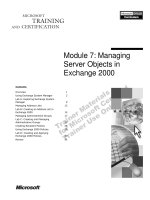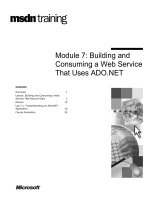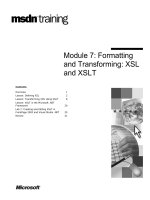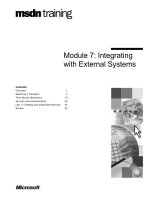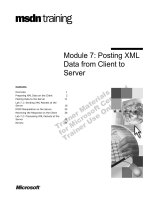Tài liệu Module 7 More Data Types and Operators docx
Bạn đang xem bản rút gọn của tài liệu. Xem và tải ngay bản đầy đủ của tài liệu tại đây (776 KB, 36 trang )
1
C++ A Beginner’s Guide by Herbert Schildt
Module 7
More Data Types and Operators
Table of Contents
CRITICAL SKILL 7.1: The const and volatile Qualifiers 2
CRITICAL SKILL 7.2: extern 5
CRITICAL SKILL 7.3: static Variables 6
CRITICAL SKILL 7.4: register Variables 10
CRITICAL SKILL 7.5: Enumerations 12
CRITICAL SKILL 7.6 typedef 16
CRITICAL SKILL 7.8: The Shift Operators 22
CRITICAL SKILL 7.9: The ? Operator 29
CRITICAL SKILL 7.10: The Comma Operator 31
CRITICAL SKILL 7.11: Compound Assignment 33
CRITICAL SKILL 7.12: Using sizeof 33
This module returns to the topics of data types and operators. In addition to the data types that you
have been using so far, C++ supports several others. Some of these consist of modifiers added to the
types you already know about. Other data types include enumerations and typedefs. C++ also provides
several additional operators that greatly expand the range of programming tasks to which C++ can be
applied. These operators include the bitwise, shift, ?, and sizeof operators.
2
C++ A Beginner’s Guide by Herbert Schildt
CRITICAL SKILL 7.1: The const and volatile Qualifiers
C++ has two type qualifiers that affect the ways in which variables can be accessed or modified. These
modifiers are const and volatile. Formally called the cv-qualifiers, they precede the base type when a
variable is declared.
const
A variable declared with the const modifier cannot have its value changed during the execution of your
program. Thus, a const “variable” isn’t really variable! You can give a variable declared as const an initial
value, however. For example,
const int max_users = 9;
creates an int variable called max_users that contains the value 9. This variable can be used in
expressions like any other variable, but its value cannot be modified by your program.
A common use of const is to create a named constant. Often programs require the same value for many
different purposes. For example, a program might have several different arrays that are all the same
size. In this case, you can specify the size of the arrays using a const variable. The advantage to this
approach is that if the size needs to be changed at a later date, you need change only the value of the
const variable and then recompile the program. You don’t need to change the size in each array
declaration. This approach avoids errors and is easier, too. The following example illustrates this
application of const:
In this example, if you need to use a new size for the arrays, you need change only the declaration of
num_employees and then recompile the program. All three arrays will then automatically be resized.
Another important use of const is to prevent an object from being modified through a pointer. For
example, you might want to prevent a function from changing the value of the object pointed to by a
parameter. To do this, declare a pointer parameter as const. This prevents the object pointed to by the
parameter from being modified by a function. That is, when a pointer parameter is preceded by const,
3
C++ A Beginner’s Guide by Herbert Schildt
no statement in the function can modify the variable pointed to by that parameter. For example, the
negate( ) function in the following program returns the negation of the value pointed to by its
parameter. The use of const in the parameter declaration prevents the code inside the function from
modifying the value pointed to by the parameter.
Since val is declared as being a const pointer, the function can make no changes to the value pointed to
by val. Since negate( ) does not attempt to change val, the program compiles and runs correctly.
However, if negate( ) were written as shown in the next example, a compile-time error would result.
In this case, the program attempts to alter the value of the variable pointed to by val, which is prevented
because val is declared as const.
The const modifier can also be used on reference parameters to prevent a function from modifying the
object referenced by a parameter. For example, the following version of negate( ) is incorrect because it
attempts to modify the variable referred to by val:
4
C++ A Beginner’s Guide by Herbert Schildt
volatile
The volatile modifier tells the compiler that a variable’s value may be changed in ways not explicitly
specified by the program. For example, the address of a global variable might be passed to an
interrupt-driven clock routine that updates the variable with each tick of the clock. In this situation, the
contents of the variable are altered without the use of any explicit assignment statement in the
program. The reason the external alteration of a variable may be important is that a C++ compiler is
permitted to automatically optimize certain expressions, on the assumption that the content of a
variable is unchanged if it does not occur on the left side of an assignment statement. However, if
factors beyond program control change the value of a variable, then problems can occur. To prevent
such problems, you must declare such variables volatile, as shown here:
volatile int current_users;
Because it is declared as volatile, the value of current_users will be obtained each time it is referenced.
1. Can the value of a const variable be changed by the program?
2. If a variable has its value changed by events outside the program, how should that variable be
declared?
Storage Class Specifiers
There are five storage class specifiers supported by C++. They are
auto
extern
register
static
mutable
These are used to tell the compiler how a variable should be stored. The storage specifier
precedes the rest of the variable declaration. The mutable specifier applies only to class objects, which
are discussed later in this book.
5
C++ A Beginner’s Guide by Herbert Schildt
Each of the other specifiers is examined here.
auto
The auto specifier declares a local variable. However, it is rarely (if ever) used, because local variables
are auto by default. It is extremely rare to see this keyword used in a program. It is a holdover from the
C language.
CRITICAL SKILL 7.2: extern
All the programs that you have worked with so far have been quite small. However, in reality, computer
programs tend to be much larger. As a program file grows, the compilation time eventually becomes
long enough to be annoying. When this happens, you should break your program into two or more
separate files. Then, changes to one file will not require that the entire program be recompiled. Instead,
you can simply recompile the file that changed, and link the existing object code for the other files. The
multiple file approach can yield a substantial time savings with large projects. The extern keyword helps
support this approach. Let’s see how.
In programs that consist of two or more files, each file must know the names and types of the global
variables used by the program. However, you cannot simply declare copies of the global variables in
each file. The reason is that your program can only have one copy of each global variable. Therefore, if
you try to declare the global variables needed by your program in each file, an error will occur when the
linker tries to link the files. It will find the duplicated global variables and will not link your program. The
solution to this dilemma is to declare all of the global variables in one file and use extern declarations in
the others, as shown in Figure 7-1.
File One declares x, y, and ch. In File Two, the global variable list is copied from File One, and the extern
specifier is added to the declarations. The extern specifier allows a variable to be made known to a
module, but does not actually create that variable. In other words, extern lets the compiler know what
the types and names are for these global variables without actually creating storage for them again.
When the linker links the two modules together, all references to the external variables are resolved.
While we haven’t yet worried about the distinction between the declaration and the definition of a
variable, it is important here. A declaration declares the name and type of a variable. A definition causes
storage to be allocated for the variable. In most cases, variable declarations are also definitions.
However, by preceding a variable name with the extern specifier, you can declare a variable without
defining it.
6
C++ A Beginner’s Guide by Herbert Schildt
A variation on extern provides a linkage specification, which is an instruction to the compiler about how
a function is to be handled by the linker. By default, functions are linked as C++ functions, but a linkage
specification lets you link a function for a different type of language. The general form of a linkage
specifier is shown here:
extern “language” function-prototype
where language denotes the desired language. For example, this specifies that myCfunc( ) will have C
linkage:
extern "C" void myCfunc();
All C++ compilers support both C and C++ linkage. Some may also allow linkage specifiers for FORTRAN,
Pascal, or BASIC. (You will need to check the documentation for your compiler.) You can specify more
than one function at a time using this form of the linkage specification:
extern “language” { prototypes
}
For most programming tasks, you won’t need to use a linkage specification.
CRITICAL SKILL 7.3: static Variables
Variables of type static are permanent variables within their own function or file. They differ from global
variables because they are not known outside their function or file. Because static affects local variables
differently than it does global ones, local and global variables will be examined separately.
static Local Variables
When the static modifier is applied to a local variable, permanent storage for the variable is allocated in
much the same way that it is for a global variable. This allows a static variable to maintain its value
between function calls. (That is, its value is not lost when the function returns, unlike the value of a
7
C++ A Beginner’s Guide by Herbert Schildt
normal local variable.) The key difference between a static local variable and a global variable is that the
static local variable is known only to the block in which it is declared.
To declare a static variable, precede its type withthe word static. For example, this statement declares
count as a static variable:
static int count;
A static variable may be given an initial value. For example, this statement gives count an initial value of
200:
static int count = 200;
Local static variables are initialized only once, when program execution begins, not each time the block
in which they are declared is entered.
The static local variable is important to functions that must preserve a value between calls. If static
variables were not available, then global variables would have to be used—opening the door to possible
side effects.
To see an example of a static variable, try this program. It keeps a running average of the numbers
entered by the user.
8
C++ A Beginner’s Guide by Herbert Schildt
Here, the local variables sum and count are both declared as static and initialized to 0. Remember, for
static variables the initialization only occurs once—not each time the function is entered. The program
uses running_avg( ) to compute and report the current average of the numbers entered by the user.
Because both sum and count are static, they will maintain their values between calls, causing the
program to work properly. To prove to yourself that the static modifier is necessary, try removing it and
running the program. As you can see, the program no longer works correctly, because the running total
is lost each time running_avg( ) returns.
static Global Variables
When the static specifier is applied to a global variable, it tells the compiler to create a global variable
that is known only to the file in which the static global variable is declared. This means that even though
the variable is global, other functions in other files have no knowledge of it and cannot alter its contents.
Thus, it is not subject to side effects. Therefore, for the few situations where a local static variable
cannot do the job, you can create a small file that contains only the functions that need the global static
variable, separately compile that file, and use it without fear of side effects. For an example of global
9
C++ A Beginner’s Guide by Herbert Schildt
static variables, we will rework the running average program from the preceding section. In this version,
the program is broken into the two files shown here. The function reset( ), which resets the average, is
also added.
Here, sum and count are now global static variables that are restricted to the second file. Thus, they can
be accessed by both running_avg( ) and reset( ) in the second file, but not elsewhere. This allows them
10
C++ A Beginner’s Guide by Herbert Schildt
to be reset by a call to reset( ) so that a second set of numbers can be averaged. (When you run the
program, you can reset the average by entering –2.) However, no functions outside the second file can
access those variables. For example, if you try to access either sum or count from the first file, you will
receive an error message.
To review: The name of a local static variable is known only to the function or block of code in which it is
declared, and the name of a global static variable is known only to the file in which it resides. In essence,
the static modifier allows variables to exist that are known to the scopes that need them, thereby
controlling and limiting the possibility of side effects. Variables of type static enable you, the
programmer, to hide portions of your program from other portions. This can be a tremendous
advantage when you are trying to manage a very large and complex program.
Ask the Expert
Q: I have heard that some C++ programmers do not use static global variables. Is this true?
A: Although static global variables are still valid and widely used in C++ code, the C++ Standard
discourages their use. Instead, it recommends another method of controlling access to global variables
that involves the use of namespaces, which are described later in this book. However, static global
variables are widely used by C programmers because C does not support namespaces. For this reason,
you will continue to see static global variables for a long time to come.
CRITICAL SKILL 7.4: register Variables
Perhaps the most frequently used storage class specifier is register. The register modifier tells the
compiler to store a variable in such a way that it can be accessed as quickly as possible. Typically, this
means storing the variable either in a register of the CPU or in cache memory. As you probably know,
accessing the registers of the CPU (or cache memory) is fundamentally faster than accessing the main
memory of the computer. Thus, a variable stored in a register will be accessed much more quickly than if
that variable had been stored in RAM. Because the speed by which variables can be accessed has a
profound effect on the overall speed of your programs, the careful use of register is an important
programming technique.
Technically, register is only a request to the compiler, which the compiler is free to ignore. The reason
for this is easy to understand: there are a finite number of registers (or fast-access memory), and these
may differ from environment to environment. Thus, if the compiler runs out of fast-access memory, it
simply stores the variable normally. Generally, this causes no harm, but of course the register advantage
is lost. You can usually count on at least two variables being optimized for speed. Since only a limited
number of variables can actually be granted the fastest access, it is important to choose carefully those
to which you apply the register modifier. (Only by choosing the right variables can you gain the greatest
increase in performance.) In general, the more often a variable is accessed, the more benefit there will
11
C++ A Beginner’s Guide by Herbert Schildt
be to optimizing it as a register variable. For this reason, variables that control or are accessed within
loops are good candidates for the register specifier.
Here is an example that uses register variables to improve the performance of the summation( )
function, which computes the summation of the values in an array. This example assumes that only two
variables will actually be optimized for speed.
Here, the variable i, which controls the for loop, and sum, which is accessed inside the loop, are
specified as register. Since they are both used within the loop, both benefit from being optimized for
fast access. This example assumed that only two variables could actually be optimized for speed, so n
and nums were not specified as register because they are not accessed as often as i and sum within the
loop. However, in environments in which more than two variables can be optimized, they too could be
specified as register to further improve performance.
1. A static local variable ___________ its value between function calls.
12
C++ A Beginner’s Guide by Herbert Schildt
2. You use extern to declare a variable without defining that variable. True or false?
3. What specifier requests that the compiler optimize a variable for speed?
Ask the Expert
Q: When I tried adding the register specifier to a program, I saw no change in performance. Why not?
A: Because of advances in compiler technology, most compilers today will automatically optimize
your code. Thus, in many cases, adding the register specifier to a declaration might not result in any
performance increase because that variable is already optimized. However, in some cases, using register
is still beneficial because it lets you tell the compiler which variables you think are the most important to
optimize. This can be valuable for functions that use a large number of variables, all of which cannot be
optimized. Thus, register still fulfills an important role despite advances in compiler design.
CRITICAL SKILL 7.5: Enumerations
In C++, you can define a list of named integer constants. Such a list is called an enumeration. These
constants can then be used anywhere that an integer can. Enumerations are defined using the keyword
enum and have this general format:
enum type-name { value-list } variable-list;
Here, type-name is the type name of the enumeration. The value-list is a comma-separated list of names
that represent the values of the enumeration. The variable-list is optional because variables may be
declared later using the enumeration type name.
The following fragment defines an enumeration called transport and two variables of type transport
called t1 and t2:
enum transport { car, truck, airplane, train, boat } t1, t2;
Once you have defined an enumeration, you can declare additional variables of its type using its name.
For example, this statement declares one variable, called how, of enumeration transport:
transport how;
The statement can also be written like this:
enum transport how;
However, the use of enum here is redundant. In C (which also supports enumerations), this second form
was required, so you may see it used in some programs.
Assuming the preceding declarations, the following gives how the value airplane:
13
C++ A Beginner’s Guide by Herbert Schildt
how = airplane;
The key point to understand about an enumeration is that each of the symbols stands for an integer
value. As such, they can be used in any integer expression. Unless initialized otherwise, the value of the
first enumeration symbol is 0, the value of the second symbol is 1, and so forth. Therefore,
cout << car << ' ' << train;
displays 0 3.
Although enumerated constants are automatically converted to integers, integers are not automatically
converted into enumerated constants. For example, the following statement is incorrect:
how = 1; // Error
This statement causes a compile-time error because there is no automatic conversion from integer to
transport. You can fix the preceding statement by using a cast, as shown here:
how = (transport) 1; // now OK, but probably poor style
This causes how to contain the value truck, because it is the transport constant associated with the
value 1. As the comment suggests, although this statement is now correct, it would be considered to be
poor style except in unusual circumstances.
It is possible to specify the value of one or more of the enumerated constants by using an initializer. This
is done
by
following the symbol with an equal sign and an integer value. When an initializer is used, each symbol
that appears after it is assigned a value 1 greater than the previous initialization value. For example, the
following statement assigns the value of 10 to airplane:
enum transport { car, truck, airplane = 10, train, boat };
Now, the values of these symbols are as follows:
car
0
truck
1
airplane
10
train
11
boat
12
14
C++ A Beginner’s Guide by Herbert Schildt
One common, but erroneous, assumption sometimes made about enumerations is that the symbols can
be input and output as a string. This is not the case. For example, the following code fragment will not
perform as desired:
// This will not print "train" on the screen. how = train; cout << how;
Remember, the symbol train is simply a name for an integer; it is not a string. Thus, the preceding code
will display the numeric value of train, not the string “train”. Actually, to create code that inputs and
outputs enumeration symbols as strings is quite tedious. For example, the following code is needed in
order to display, in words, the kind of transportation that how contains:
Sometimes it is possible to declare an array of strings and use the enumeration value as an index in
order to translate the value into its corresponding string. For example, the following program prints the
names of three types of transportation:
15
C++ A Beginner’s Guide by Herbert Schildt
The output is shown here:
Automobile
Airplane
Train
The approach used by this program to convert an enumeration value into a string can be applied to any
type of enumeration as long as that enumeration does not contain initializers. To properly index the
array of strings, the enumerated constants must begin at zero and be in strictly ascending order, each
precisely one greater than the previous. Given the fact that enumeration values must be converted
manually to their human-readable string values, they find their greatest use in routines that do not
make such conversions. It is common to see an enumeration used to define a compiler’s symbol table,
for example.
16
C++ A Beginner’s Guide by Herbert Schildt
CRITICAL SKILL 7.6 typedef
C++ allows you to define new data type names with the typedef keyword. When you use typedef, you
are not actually creating a new data type, but rather defining a new name for an existing type. This
process can help make machine-dependent programs more portable; only the typedef statements have
to be changed. It also helps you self-document your code by allowing descriptive names for the standard
data types. The general form of the typedef statement is
typedef type name;
where type is any valid data type, and name is the new name for this type. The new name you define is
in addition to, not a replacement for, the existing type name.
For example, you could create a new name for float using
typedef float balance;
This statement would tell the compiler to recognize balance as another name for float. Next, you could
create a float variable using balance:
balance over_due;
Here, over_due is a floating-point variable of type balance, which is another name for float.
1. An enumeration is a list of named ________ constants.
2. Enumerated values begin with what integer value?
3. Show how to declare BigInt to be another name for long int.
CRITICAL SKILL 7.7: Bitwise Operators
Since C++ is designed to allow full access to the computer’s hardware, it gives you the ability to operate
directly upon the bits within a byte or word. Toward this end, C++ contains the bitwise operators.
Bitwise operations refer to the testing, setting, or shifting of the actual bits in a byte or word, which
correspond to C++’s character and integer types. Bitwise operations cannot be used on bool, float,
double, long double, void, or other more complex data types. Bitwise operations are important in a wide
variety of systems-level programming, especially when status information from a device must be
interrogated or constructed. Table 7-1 lists the bitwise operators. Each operator is examined in turn.
17
C++ A Beginner’s Guide by Herbert Schildt
AND, OR, XOR, and NOT The bitwise AND, OR, and one’s complement (NOT) are
governed by the same truth table as their logical equivalents, except that they work on a bit-by-bit level.
The exclusive OR (XOR) operates according to the following truth table:
As the table indicates, the outcome of an XOR is true only if exactly one of the operands is true; it is false
otherwise.
In terms of its most common usage, you can think of the bitwise AND as a way to turn bits off. That is,
any bit that is 0 in either operand will cause the corresponding bit in the outcome to be set to 0. For
example:
The following program demonstrates the & by turning any lowercase letter into uppercase by resetting
the sixth bit to 0. As the ASCII character set is defined, the lowercase letters are the same as the
uppercase ones except that the lowercase ones are greater in value by exactly 32. Therefore, to
transform a lowercase letter to uppercase, just turn off the sixth bit, as this program illustrates:
18
C++ A Beginner’s Guide by Herbert Schildt
The output from this program is shown here:
aA bB cC dD eE fF gG hH iI jJ
The value 223 used in the AND statement is the decimal representation of 1101 1111. Thus, the AND
operation leaves all bits in ch unchanged except for the sixth one, which is set to zero.
The AND operator is also useful when you want to determine whether a bit is on or off. For example,
this statement checks to see if bit 4 in status is set:
if(status & 8) cout << "bit 4 is on";
The reason 8 is used is that in binary it is represented as 0000 1000. That is, the number 8 translated
into binary has only the fourth bit set. Therefore, the if statement can succeed only when bit 4 of status
is also on. An interesting use of this feature is the show_binary( ) function, shown next. It displays, in
binary format, the bit pattern of its argument. You will use show_binary( ) later in this module to
examine the effects of other bitwise operations.
19
C++ A Beginner’s Guide by Herbert Schildt
The show_binary( ) function works by successively testing each bit in the low-order byte of u, using the
bitwise AND, to determine if it is on or off. If the bit is on, the digit 1 is displayed; otherwise, 0 is
displayed.
The bitwise OR, as the reverse of AND, can be used to turn bits on. Any bit that is set to 1 in either
operand will cause the corresponding bit in the variable to be set to 1. For example,
You can make use of the OR to change the uppercasing program used earlier into a lowercasing
program, as shown here:
20
C++ A Beginner’s Guide by Herbert Schildt
The output is shown here:
Aa Bb Cc Dd Ee Ff Gg Hh Ii Jj
When the sixth bit is set, each uppercase letter is transformed into its lowercase equivalent.
An exclusive OR, usually abbreviated XOR, will set a bit on only if the bits being compared are different,
as illustrated here:
The XOR operator has an interesting property that makes it a simple way to encode a message. When
some value X is XORed with another value Y, and then when that result is XORed with Y again, X is
produced. That is, given the sequence
then R2 is the same value as X. Thus, the outcome of a sequence of two XORs using the same value
produces the original value. You can use this principle to create a simple cipher program in which some
integer is the key that is used to both encode and decode a message by XORing the characters in that
message. To encode, the XOR operation is applied the first time, yielding the ciphertext. To decode, the
XOR is applied a second time, yielding the plaintext. Here is a simple example that uses this approach to
encode and decode a short message:
21
C++ A Beginner’s Guide by Herbert Schildt
Here is the output:
Original message: This is a test
Encoded message: 01+x1+x9x,=+,
Decoded message: This is a test
As the output proves, the result of two XORs using the same key produces the decoded message.
The unary one’s complement (NOT) operator reverses the state of all the bits of the operand. For
example, if some integer called A has the bit pattern 1001 0110, then ~A produces a result with the bit
pattern 0110 1001. The following program demonstrates the NOT operator by displaying a number and
its complement in binary, using the show_binary( ) function developed earlier:
22
C++ A Beginner’s Guide by Herbert Schildt
Here is a sample run produced by the program:
Enter a number between 0 and 255: 99
Here's the number in binary: 0 1 1 0 0 0 1 1
Here's the complement of the number: 1 0 0 1 1 1 0 0
In general, &, |, ^, and ~ apply their operations directly to each bit in a value individually.
For this reason, bitwise operations are not usually used in conditional statements the way the relational
and logical operators are. For example, if x equals 7, then x && 8 evaluates to true, whereas x & 8
evaluates to false.
CRITICAL SKILL 7.8: The Shift Operators
The shift operators, >> and <<, move all bits in a variable to the right or left as specified. The general
form of the right-shift operator is
variable >> num-bits
and the left-shift operator is
variable << num-bits
The value of num-bits determines how many bit places the bits are shifted. Each left-shift causes all bits
within the specified variable to be shifted left one position and a zero bit to be brought in on the right.
Each right-shift shifts all bits to the right one position and brings in a zero on the left. However, if the
variable is a signed integer containing a negative value, then each right-shift brings in a 1 on the left,
which preserves the sign bit. Remember, a shift is not a rotation. That is, the bits shifted off of one end
do not come back around to the other.
23
C++ A Beginner’s Guide by Herbert Schildt
The shift operators work only with integral types, such as int, char, long int, or short int. They cannot be
applied to floating-point values, for example.
Bit shift operations can be very useful for decoding input from external devices such as D/A converters
and for reading status information. The bitwise shift operators can also be used to perform very fast
multiplication and division of integers. A shift left will effectively multiply a number by 2, and a shift right
will divide it by 2.
The following program illustrates the effects of the shift operators:
24
C++ A Beginner’s Guide by Herbert Schildt
This program produces the following output:
1. What are the bitwise operators for AND, OR, NOT, and XOR?
2. A bitwise operator works on a bit-by-bit basis. True or false?
3. Given an integer called x, show how to left-shift x two places.
Although C++ provides two shift operators, it does not define a rotate operator.
A rotate is similar to a shift except that the bit shifted off one end is inserted onto the other end. Thus,
bits are not lost, just moved. There are both left and right rotations. For example, 1010 0000 rotated left
one place is 0100 0001. The same value rotated right one place is 0101 0000. In each case, the bit
shifted out is inserted onto the other end. Although the lack of rotation operators may seem to be a
25
C++ A Beginner’s Guide by Herbert Schildt
flaw in C++’s otherwise exemplary complement of bitwise operators, it really isn’t, because you can
easily create a left- and right-rotate by using the other bitwise operators.
This project creates two functions: rrotate( ) and lrotate( ), which rotate a byte in the right or left
direction. Each function takes two parameters. The first is the value to be rotated.
The second is the number of places to rotate. Each function returns the result. This project involves
several bit manipulations and shows the bitwise operators in action.
Step by Step
1. Create a file called rotate.cpp.
2. Add the lrotate( ) function shown here. It performs a left-rotate.
Here is how lrotate( ) works. The function is passed the value to rotate in val, and the number of places
to rotate is passed in n. The function assigns val to t, which is an unsigned int. Transferring the value to
an unsigned int is necessary because it allows bits shifted off the left side to be recovered. Here’s why.
Because an unsigned int is larger than a byte, when a bit is shifted off the left side of a byte value, it
simply moves to bit 8 of the integer value. The value of this bit can then be copied into bit 0 of the byte
value, thus performing a rotation.
The actual rotation is performed as follows: A loop is established that performs the required number of
rotations, one at a time. Inside the loop, the value of t is left-shifted one place. This causes a 0 to be
